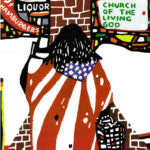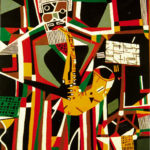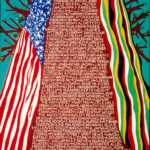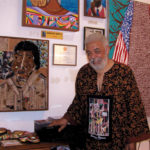by Lydia Gans
[dropcap]I[/dropcap]t is impossible to look at Arnold White’s art casually; it draws you in, makes you think. It forces you to look for the meanings in all the many details and rewards you with a sense of communion with the artist. Creating art to put across a message is what Arnold White is all about.
Describing his paintings about homelessness and drug abuse, about Rodney King, police brutality, and all sorts of social and political issues, White explains his purpose: “I hope that when a person views the art, they can virtually go inside the canvas, feel and see what the message is that I’m giving here, and not just look at the art in terms of color and quickly move on.”
To help that happen, White engages the viewer in a dialogue about the art whenever possible — like when he finds a person looking at his work in his studio or in an exhibit. And he goes further. He regularly takes his works to schools all over the Bay Area to generate discussions with young people around the statements he is making, which then lead into conversations about the larger issues confronting young people in their lives.
White puts as much passion and energy into his school visits as he does into the creation of his art. He talks about walking into a roomful of unruly kids, getting them to quiet down, and to look at a painting he puts in front of them, “The Bag Lady,” for instance, or “The Beating Of Rodney King.” Gradually he gets their attention, engages them in thinking and talking about what they see. They relate to his work and understand his messages.
For White, the rewards are great. The students let him know that he has made a difference in their lives. He has awakened creative impulses, inspired a new way of looking or of thinking, given them an avenue for expressing themselves. The critical thing that is missing in young people today, White says, is respect — respect for their teachers, for each other and for themselves. By his very presence there, by the message he brings them and the way he treats them, he manages to bring about a little more respect in a generally chaotic situation.
He has been doing this for 17 years, almost entirely at his own expense, since the schools rarely have money for any kind of special programs.
White’s artistic development started when he was only six years old, copying comic books. He soon evolved his own style. He sharpened his skills when he was in junior high school by drawing athletic events. In high school he painted signs and developed a steady hand in the process.
Basically, he taught himself his art and painted from his own experiences. The teachers he encountered in high school and in junior college art courses were discouraging. They didn’t appreciate his unique style and they tried to convince him that he’d “never get anywhere painting black images.”
But one teacher was special. Vincent Perez, a fine artist and a professor at California College of Arts and Crafts, recognized White’s talent and gave him the encouragement and training he was seeking. That was back in the 1970s at Chabot College; they’ve been friends ever since.
White’s social consciousness started at a very young age. He grew up in West Oakland, graduating from McClymonds High School in 1956. His family was poor and life was a struggle. His mother earned 10 cents an hour working as a domestic for rich families in Piedmont. He tells the story of how his father once found $1.50, which fed the family of six for a week.
Arnold also read magazines and went to the movies where he got a different view of life in the United States. Why are black people never portrayed in strong, positive roles in the movies? Why do white people live in stylish homes in another part of town? Why is there discrimination? He already was asking those questions back in junior high school and, he says ruefully, “I have to say I was pretty well reprimanded for speaking out about the social ills that I saw.”
There were periods in his life when he didn’t do very much art work, but he got seriously back into it in 1986 and created 17 paintings in the course of the next year. Now his art is the focus of his life. The North Oakland building he lives in contains his gallery, work space and living quarters. He works at the post office and then, he says, “I come home here to my art. This is my life work.”
His paintings are full of brilliant colors and intricate details. His montages, assemblages and “masks” are fascinating. Stand up close and you see nails and wires, polished wood, beads, a shiny comb or an old sink strainer. Step back and it’s a face, a figure, an attitude. Every detail has a message, every symbol carries a meaning.
Listening to White talk about his reasons for the various forms and materials that he uses adds another dimension to the experience of seeing his works. White welcomes visitors to his gallery at 5975 Shattuck Avenue. It is open to the public Wednesday through Saturday afternoons after 3:30 p.m.
When White explains his purpose in art and in his life, it’s an inspiration to all of us who are looking to give meaning to our own struggle to create a better world.
He explains, “Through my art I show the plight, struggle, humanity, and the seeking of justice of the human race. I will always paint the message of humankind — the unheard voices, the denied, the neglected, the grass roots. To address and redress social issues — to wake up America and the world to the way it ought to be. My art is my lifeblood — my contribution to the need for the oneness of humankind — and the absolute need for world peace.”
The Bag Lady in Red, White and Blue
by Arnold White

The Bag Lady piece is my statement about homeless people. I think society really doesn’t want to see the situation. “Put it over there in the corner, it will go away. Don’t bother me.” But it’s happening, it’s reality, it’s here. So my painting really zeroes in on society turning their back, not doing anything about this situation. Here we have a woman walking down the street with her bags in one arm, pulling her cart. White on each side of her, which is a statement about the snow, or the winter time.
In my art there are a lot of messages. I put a One Way sign at the top. People can read into that what they wish, but for me it’s a statement that she only has one way to go. The church, that is a statement about the inner city. What we find in the inner city is a church on one corner and a liquor store on another. So you drink yourself crazy and go save your soul. Or you praise the lord and go jump in the bottle. It’s a contradiction, but you’ll find it block after block in the inner city.
There’s a brick wall above her head, and her body can’t possibly get through that opening. But even if she turned sideways and squeezes through, still she’s faced with a brick wall. There’s a pawn shop, a statement about pawning the last thing she owns to survive. She’s draped in the American flag as her clothing. Some people will ask me, “What’s this about? Her dress is an American flag.” I say, “Yeah, that’s my statement.”
Society doesn’t want to see it. They turn their back. So I put society on her back as a sense of responsibility. It says that something needs to be done about this. Why in this country with the potential for so much greatness should people live in the streets and eat from garbage cans?
Bag Lady, Bag Lady
by Arnold White
There you stand — in all your
Magnificent beauty…
Draped in the red, white and blue
looking like Sister Sadie.
The Church on one corner, the
Liquor store on another, unnh-
unnh-unnh, what a contradiction
And how many of you are out
there behind the Bush, the
Reagans and the Nixons?
Do you only have one way
to go Bag Lady? And do you
Have to search for the last
Thing you own to pawn and
Then pray – that – you – will – live
to – see – yet – another – dawn.
It’s not so much that you’re
Looking for utopia — as much
As you’re looking for a meal —
And a place to stay and lay —
And one more night of
Escaping the rope-a-dopeia.
Bag Lady, Bag Lady…
America!! You need to wake up!!
America!! We must wake up.
Bag Lady, Bag Lady…
I love you — I recognize you —
I embrace you — and truly,
Truly I do understand — that
If we turn you around — you
Could very well be ME or YOU
Bag Lady, Bag Lady,
Think about it…





